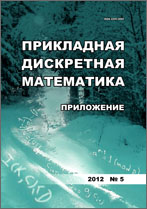|
Mathematical Methods of Cryptography
One approach to constructing a multiply transitive class of block transformations
I. V. Cherednik
MIREA — Russian Technological University, Moscow
Abstract:
Let Ω be an arbitrary finite set, B(Ω) — the collection of all binary operations defined on the set Ω, B∗(Ω) — the family of all binary operations that are invertible in the right variable, x1,…,xn — variables over Ω, and ∗1,…,∗k — general symbols of binary operations. A fixed cortege W=(w1,…,wm) of formulas in the alphabet {x1,…,xn,∗1,…,∗k} implements the mapping WF1,…,Fk:Ωn→Ωm when replacing symbols ∗1,…,∗k with an arbitrary binary operations F1,…,Fk∈B(Ω), respectively. In this paper we offer a visual representation of the transformation family {WF1,…,Fk:F1,…,Fk∈B∗(Ω)} in the form of a binary functional network. This representation allows us to strictly describe the methods of research on the multiply transitivity of an arbitrary family {WF1,…,Fk:F1,…,Fk∈B∗(Ω)}. In addition, network view makes it possible to construct cortege of formulas W=(w1,…,wn) such that the family {WF1,…,Fk:F1,…,Fk∈B∗(Ω)} is multiply transitive. Moreover, some block ciphers (Blowfish, Twofish, etc), in which the S-boxes depend on the key, can be “approximated” by family of the form {WF1,…,Fk:F1,…,Fk∈B∗(Ω)} and, as a result, it becomes possible to evaluate the multiple transitivity of such ciphers.
Keywords:
block transformation, multiply transitive class of block transformations, functional binary network.
Citation:
I. V. Cherednik, “One approach to constructing a multiply transitive class of block transformations”, Prikl. Diskr. Mat. Suppl., 2020, no. 13, 69–71
Linking options:
https://www.mathnet.ru/eng/pdma501 https://www.mathnet.ru/eng/pdma/y2020/i13/p69
|

| Statistics & downloads: |
| Abstract page: | 124 | | Full-text PDF : | 53 | | References: | 28 |
|




 Contact us:
Contact us: Terms of Use
Terms of Use
 Registration to the website
Registration to the website Logotypes
Logotypes









 Citation in format
Citation in format 